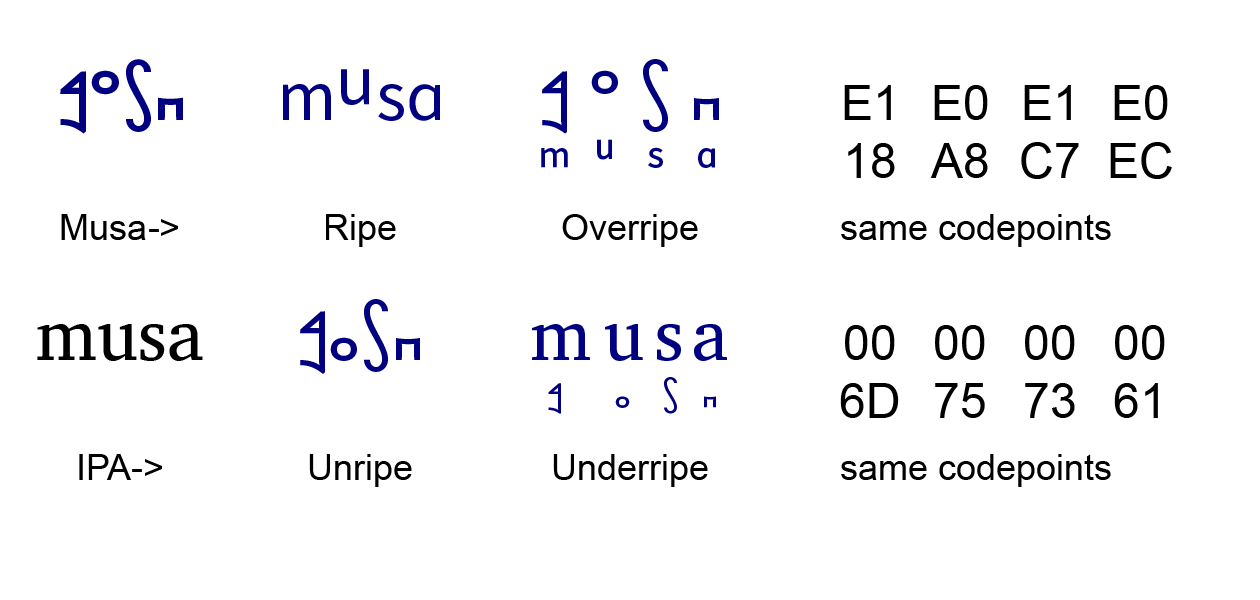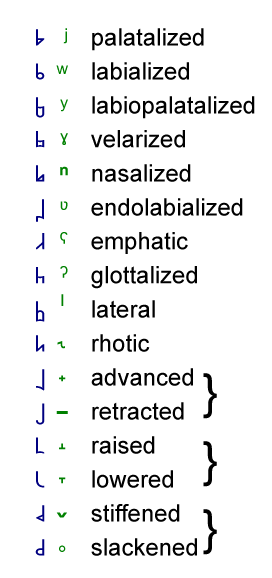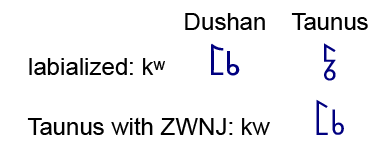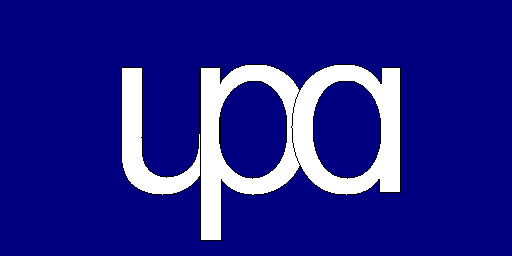This page collects some detailed explanations and an assortment of useful resources for people who already understand how Musa works, but are just now trying to use it to spell pronunciation with the same level of precision as the International Phonetic Alphabet (IPA).
But the goal of using Musa to spell pronunciation is not just to provide the same or better coverage as the IPA and similar scripts, it's also to offer an orthography that's so easy to learn, easy to use, and clear that we use it everywhere: in dictionaries and encyclopedias, in tourist guides, in language textbooks, and everywhere that we need to spell pronunciation.
Among the resources on the website, you can find a page of charts showing the correspondences between IPA and Musa, a transcriber with which you can convert IPA (or X-SAMPA or Kirshenbaum) to Musa, and an IPA/Musa typewriter.
Transliteration Fonts
We also offer several fonts that transliterate between Musa and the IPA. To use them, all you need to do is highlight the text you want to transliterate and choose one of these fonts:
The Ripe Musa Trans font ("Ripe" stands for Roman IPA) replaces Musa letters with the corresponding IPA letters, while the Overripe Musa Ruby font puts IPA letters underneath the Musa spelling. Both of these put IPA in the Musa codepoints.
Going in the other direction, the Unripe Musa Trans font replaces IPA letters with the corresponding Musa letters, while the Underripe Musa Ruby font puts Musa letters underneath the IPA. Both of those put Musa in IPA codepoints.

Here's a sample of Overripe:
A great way to use these fonts online is to create transliteration tooltips that appear when you hover the mouse over the text. Try hovering the mouse over the following line:
Here's the CSS: #yourtext:hover {font-family: 'Ripe Musa Trans'; color: DarkGreen;}
Vocalization
If you need to describe the pronunciation of English vowels - a very common problem since their spelling is so crazy - then we have a great solution for you: the Pygmalion Musa Diacritic font.
Pygmalion writes small Musa vowels over the English vowels, so you know how they're pronounced by reference to a legend at the bottom of the page. Here's one for General American:

There's another font called Galatea Musa Diacritic that can put both vowels and consonants over Roman letters:
Vowel Quality
The notation above handles the first two formants and rounding, and the three vowel suffixes handle length, nasality, and rhoticity. But we still have to handle vowel quality (phonation).
For that, we use accent marks. This choice seems confusing: how can reader know whether an accent indicates a pitch tone or an unusual vowel quality? But in fact, there is no firm line between vowel quality and tone: many tones involve more than just musical pitch. And the tone spelled with the same accent may sound different in different languages, anyway.
So for languages without pitch tone, we have a standard set of interpretations for the three accent marks, both high and low:
-
A Rising accent is used to indicate the vowel is lengthened, aspirated, slack, hollow, or breathy.
A Falling accent is used to indicate the vowel is clipped, glottalized, stiff, harsh, or creaky.
For instance, this is how Musa writes Danish stød. A Level accent is used to indicate the vowel is voiceless.
We use this accent in Japanese for whispered vowels (母音の無声化).
Note that we're trying to make a fine distinction between a long vowel and a lengthened vowel, and likewise between a short vowel and a shortened or clipped vowel. When the length is part of the vowel, we use the long mark. When the lengthening is applied to a vowel which isn't inherently long, but is made longer by the context, then we use the Rising accent, and likewise for short versus clipped vowels.
When used along with vowel digraphs, we go into even more detail: both vowels bear accents. The accent on the first vowel follows the pattern above, while the accent on the second vowel specifies the exact phonation:
-
No accent on the second vowel means the vowel is aspirated or glottalized.
A Rising accent on the second vowel is used to indicate the vowel is slack or stiff.
A Falling accent on the second vowel is used to indicate the vowel is hollow or harsh.
A Level accent on the second vowel is used to indicate the vowel is breathy or creaky.
So for example, the Danish word for dog, hund, would be written for Danes and for phoneticians.
The notation above works pretty well for vowels, when it's only the quality of a single vowel that you want to spell. But voicings like creaky voice, harsh voice, and whisper are often used for entire words or even longer stretches of speech. For those cases, and for the many other unusual types of voice quality, Musa uses orthophonic affixes. You can read all about them on the previous page.
IPA Diacritics
The IPA sure has a lot of diacritics: 31 of them, plus 7 suprasegmentals (we won't even talk about tones and intonation here). Most of them are only needed in narrow phonetic transcription, not for everyday spelling or even allophonic transcription. Musa has only 16 suffixes to cover the same scope, mostly because in many cases Musa offers single letters that incorporate the missing diacritic. In this section, we'll explain how that's done, treating each IPA diacritic in the order it appears in the IPA charts.
-
Voiceless ◌̥ and Voiced ◌̬: The IPA diacritics explicitly reverse the normal voicing of the letter, but Musa already has letters for voiceless approximants, laterals, rhotics, and nasals (but not for every one). When otherwise needed, the Musa equivalents are , but they have more general meanings. The Slackening suffix could be applied to a voiced letter to spell a slack consonant, to a breathy letter to indicate whisper, or to an unvoiced letter to indicate hollow voice. The Stiffening suffix could be applied to an voiced letter to indicate a stiff sound, to a breathy letter to indicate a creaky sound, or to an unvoiced letter to indicate a harsh sound. (Vowels use accents to modify voice quality.)
Aspirated ◌ʰ: Musa has letters for aspirated plosives and affricates, but for aspirated fricatives, we use the letters for unvoiced fricatives followed by ; we use the Musa h as if it were a superscript ʰ. We would also use this letter as a prefix to spell pre-aspiration.
More Rounded ◌̹ and Less Rounded ◌̜: When we need this level of detail for vowels, we use the vowel Digraphs, explained above. The rounding of the second vowel either exaggerates or contradicts the rounding of the first.
Advanced ◌̟ and Retracted ◌̠: Musa has exact equivalents .
Centralized ◌̈ and Mid-Centralized ◌̽: Again, this is a case for vowel Digraphs.
Syllabic ◌̩ and Non-Syllabic ◌̯: For syllabic consonants, the Long mark is used without a preceding vowel to indicate a missing vowel. If the syllabic consonant is nasal, we use the Nasal mark instead. To indicate a non-syllabic vowel, just use the corresponding semivowel.
Rhoticity ◌˞: Musa has a letter for a central rhotic vowel ɝ or ɚ. For other rhotic sounds, we use the rhotic suffix .
Breathy Voiced ◌̤ and Creaky Voiced ◌̰: Musa has letters for breathy obstruents, and uses the voiceless letters for murmured sonorants. For vowels, we use accents as described in the Vowel Quality section above: a rising accent for Breathy, and a Falling accent for Creaky. For more precision, use the Breathy and Creaky suffixes .
Linguolabial ◌̼: We spell linguolabial letters using the suffix.
Labialized ◌ʷ, Palatalized ◌ʲ, and Velarized ◌ˠ: Musa has exact analogs for these: labialized , palatalized , and velarized . Musa also has a suffix for when a letter is both palatalized and labialized ◌ᶣ, as in the Russian word нёс (in effect, palatalization before a rounded vowel). And Musa has a suffix for when a letter is labialized ◌ᶹ, but without protrusion of the lips - the mouth opening is small, but the lips are compressed. The pair thus allows you to contrast exolabial and endolabial rounding.
Pharyngealized ◌ˤ and Velarized or Pharyngealized ◌̴: Musa has a pharyngealizing suffix , which is used for the emphatic consonants of Arabic and other Semitic languages (unless they're realized as velarized, ejective, implosive, or plain).
Raised ◌̝ and Lowered ◌̞: Musa has exact equivalents, , which are used both with consonants and as offglides with vowels. Musa, like the IPA, doesn't have separate letters for many fricatives and approximants, and that's rarely a problem for writing a language. But phoneticians can use the raising and lowering suffixes to distinguish them for more precise transcription.
Advanced ◌̘ and Retracted ◌̙ Tongue Root: Musa uses lazy letters to spell RTR (ATR-) sounds, as if they were lax.
Dental ◌̪ and Alveolar, Apical ◌̺ and Laminal ◌̻: Musa has suffixes that not only show whether a sound is Dental or Alveolar, but even whether it is apical or laminal: .
Nasalized ◌̃ and Nasal Release ◌ⁿ: Musa uses the Nasal mark as a suffix to spell nasal vowels, and the Prenasal prefix to spell prenasalized consonants. For consonants with nasal release, Musa uses the Prenasal prefix as a suffix.
Lateral Release ◌ˡ: Musa has a bottom for consonants with lateral release, including affricates, fricatives, and the lateral flap and click.
No Audible Release ◌̚ and Glottalization ◌ˀ: When final plosives (not followed by a vowel) are unreleased, Musa writes them with held letters. In other cases, unreleased sounds are written with a glottal suffix . A glottal suffix can also be used as a prefix to spell glottal reinforcement.
Primary Stress ◌ˈ: Musa writes stressed vowels high on the line, and unstressed vowels low.
Major (intonation) Group ‖: Musa has Intonation marks for the major prosodic unit, the intonation group.
Secondary Stress ◌ˌ and Minor (foot) Group |: In normal text, we don't write the boundaries of metrical feet, nor the secondary stress that arises from "extra" feet. However, Musa has a metrical notation for indicating secondary stress and metrical feet when needed.
Long ◌ː, Half-Long ◌ˑ, and Extra Short ◌˘: Musa uses the Long mark as a suffix to indicate long vowels, and we use the same Long mark as a prefix to indicate extra-short vowels. We have no specific symbol for half-long, but you could use long marks as both prefix and suffix, to spell a short long vowel.
Syllable Break . and Linking ◌͜◌: Musa has a letter for an unexpected syllable break , but no symbol to indicate the absence of a break except the absence of a space or other intermediate letter.
Here are the Musa suffixes again, along with the IPA diacritic they correspond to:

There are combinations of IPA symbol + diacritic that can't be written in Musa: an aspirated nasal nʰ, or ɝˡ a rhotic vowel with lateral release. Undoubtably, some are even useful. If you run across such a case, please let us know so we can address the lacuna.
Ligatures and ZWNJ
On the previous page, I mentioned that transcriptions usually use the Dushan Musa Alphabet font, which is monospace and uses no Advanced Typography features (so it will display reliably on almost any device). In Alphabet gait, these suffixes follow the letters they modify. But you may want to use Ligature gait, in which suffixes are combined with the letters they modify into ligatures - single letters that are taller (both ascenders and descenders). All you need to do is use a ligature font, like Taunus Musa Ligature.

The use of ligatures enables us to make a distinction, when needed, between a suffix and a semivowel. For example, in Proto-Indo-European, a labialized kʷ (pronounced with rounded lips) was distinct from a k followed by semivowel w: kw. In that latter case, using a ligature font, insert a Zero-Width Non-Joiner (ZWNJ, unicode 200C) between the two letters to prevent the formation of the ligature when you want to spell the semivowel form. The ZWNJ is available on a Musa keyboard as Muna
How to use Musa
The easiest way to begin using Musa is to include it alongside whenever you use IPA
You're going to need three things:
-
A font or two. I recommend Dushan (monospace, no Advanced Typography), Kraljevo (kerned, no dot), or Taunus (suffixes form ligatures). They're all available for download here.
A keyboard. On a computer, use Musa Keyboards. On a phone, use Musa Keys.
A browser extension, so you can read Musa online: Musa View
You're probably going to need a legend (as with the IPA). You can link to our IPA charts, or you can provide a legend for just the Musa letters you need showing the correspondences with the current orthography of the language you're describing (like the one above, or this one).
And that's it! You're ready to go :)
I should mention that if you need anything else: materials, utilities, clarification, even changes to Musa, that's what the Musa Academy is here for. We want to provide whatever it takes for Musa to succeed. So please don't hesitate to get in touch at musa@musa.bet.
| © 2002-2025 The Musa Academy | musa@musa.bet | 04apr25 |

